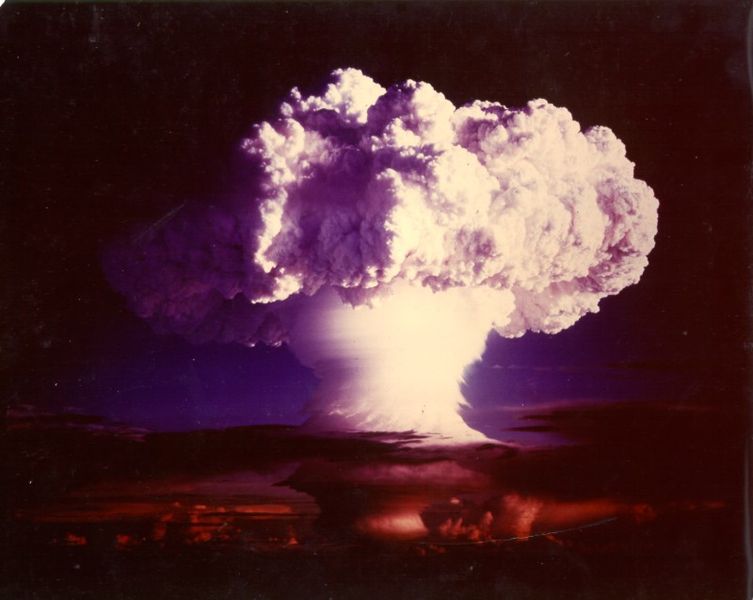The international community has pursued multilateral and bilateral treaties to limit the testing of nuclear weapons beginning in 1955, ten years after the first nuclear explosion. This article summarizes some of the most noteworthy.
Limited Test Ban Treaty (LTBT)
The Limited Test Ban Treaty, also known as the Partial Test Ban Treaty, is a treaty that prohibits nuclear weapons tests in the atmosphere, in outer space, and under water.
Negotiations for this agreement began when the Soviet Union proposed the ban of nuclear weapons tests at a meeting of the Subcommittee of Five (the United States, the United Kingdom, Canada, France, and the Soviet Union) of the U.N. Disarmament Commission in May 1955. From October 1958 to January 1962 the United States, the United Kingdom, and the Soviet Union held trilateral meetings known as the Conference of the Nuclear Weapon Tests to discuss a treaty.
These meetings, given new urgency after the 1962 Cuban Missile Crisis, resulted in the formation of the LTBT. The treaty opened for signature on August 5, 1963 and entered into force on October 10, 1963. Since then, more than 120 states have signed the treaty. For more on the LTBT, click here.
Threshold Test Ban Treaty (TTBT)
The Treaty on the Limitation of Underground Nuclear Weapon Tests, more often referred to as the Threshold Test Ban Treaty (TTBT), is a bilateral agreement signed by the United States and the Soviet Union that prohibits nuclear weapon tests that exceed 150 kilotons.
In the spring of 1974 the United States and Soviet Union agreed to meet to negotiate further restrictions to nuclear weapon tests that the LTBT did not address. The TTBT was signed that July. During negotiations, the Soviet Union noted the possibility of unintentionally testing a nuclear weapon with a yield greater than 150 kilotons—for example, if physical models predicted a weapon would yield 145 kilotons but it was more powerful than predicted. Both sides agreed that one or two unintentional breaches of the treaty’s threshold per year would not violate the treaty, though the other party would be entitled to investigate such a breach.
While the treaty was signed in 1974, it did not go into effect until December 11, 1990 after additional verification provisions were agreed on.
Peaceful Nuclear Explosions Treaty (PNET)
While negotiating the TTBT, the United States and Soviet Union determined an additional treaty regarding peaceful nuclear explosions was necessary. Negotiations for this treaty began in Moscow in October 1974. In May 1976 the two parties signed the Treaty on Underground Nuclear Explosions For Peaceful Purposes, usually called the Peaceful Nuclear Explosions Treaty (PNET). The treaty permitted the two sides to conduct underground nuclear explosions, not exceeding 150 kilotons, for non-military purposes. Like the TTBT, the PNET did not enter into force until 1990.
Comprehensive Nuclear Test Ban Treaty (CTBT)
Negotiations for a comprehensive ban of nuclear weapon tests began in January 1994. Negotiations resulted in the Comprehensive Nuclear Test Ban Treaty (CTBT). The CTBT bans all nuclear explosions.
While the treaty opened for signatures in September 1996, it has not entered into force. Article XIV of the treaty lists forty-four states that must ratify the treaty before it enters into force. Of the forty-four, China, India, Iran, Israel, North Korea, Pakistan, and the United States have not ratified the treaty.
Treaty on the Prohibition of Nuclear Weapons
Frustrated by slow progress in achieving nuclear disarmament, many non-nuclear states and non-governmental organizations have advocated for a treaty to outlaw nuclear weapons entirely. The Treaty on the Prohibition of Nuclear Weapons was approved by the United Nations General Assembly on July 7, 2017. The treaty bans the use, possession, development, testing, and transfer of nuclear weapons.
Treaty proponents point to the humanitarian consequences of using nuclear weapons and argue that the only way to ensure these weapons are never used again is to eliminate them. However, all of the nuclear-armed states and many of their allies expressed opposition to the treaty and boycotted the UN General Assembly negotiations. Among other arguments, they claim a ban is unrealistic and potentially counterproductive. For more on the treaty, click here.





